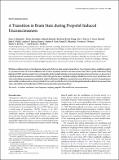| dc.contributor.author | Weiner, Veronica S. | |
| dc.contributor.author | Mukamel, Eran A. | |
| dc.contributor.author | Pirondini, Elvira | |
| dc.contributor.author | Babadi, Behtash | |
| dc.contributor.author | Wong, Kin Foon Kevin | |
| dc.contributor.author | Pierce, Eric T. | |
| dc.contributor.author | Harrell, P. Grace | |
| dc.contributor.author | Walsh, John L. | |
| dc.contributor.author | Salazar-Gomez, Andres F. | |
| dc.contributor.author | Cash, Sydney S. | |
| dc.contributor.author | Eskandar, Emad | |
| dc.contributor.author | Purdon, Patrick L. | |
| dc.contributor.author | Brown, Emery Neal | |
| dc.date.accessioned | 2014-11-12T14:17:25Z | |
| dc.date.available | 2014-11-12T14:17:25Z | |
| dc.date.issued | 2014-01 | |
| dc.date.submitted | 2013-11 | |
| dc.identifier.issn | 0270-6474 | |
| dc.identifier.issn | 1529-2401 | |
| dc.identifier.uri | http://hdl.handle.net/1721.1/91534 | |
| dc.description.abstract | Rhythmic oscillations shape cortical dynamics during active behavior, sleep, and general anesthesia. Cross-frequency phase-amplitude coupling is a prominent feature of cortical oscillations, but its role in organizing conscious and unconscious brain states is poorly understood. Using high-density EEG and intracranial electrocorticography during gradual induction of propofol general anesthesia in humans, we discovered a rapid drug-induced transition between distinct states with opposite phase-amplitude coupling and different cortical source distributions. One state occurs during unconsciousness and may be similar to sleep slow oscillations. A second state occurs at the loss or recovery of consciousness and resembles an enhanced slow cortical potential. These results provide objective electrophysiological landmarks of distinct unconscious brain states, and could be used to help improve EEG-based monitoring for general anesthesia. | en_US |
| dc.description.sponsorship | National Institutes of Health (U.S.) (Grant DP1-OD003646-01) | en_US |
| dc.description.sponsorship | National Institutes of Health (U.S.) (Grant R01-EB006385) | en_US |
| dc.description.sponsorship | National Institutes of Health (U.S.) (Grant R01-MH071847) | en_US |
| dc.language.iso | en_US | |
| dc.publisher | Society for Neuroscience | en_US |
| dc.relation.isversionof | http://dx.doi.org/10.1523/jneurosci.5813-12.2014 | en_US |
| dc.rights | Article is made available in accordance with the publisher's policy and may be subject to US copyright law. Please refer to the publisher's site for terms of use. | en_US |
| dc.source | Society for Neuroscience | en_US |
| dc.title | A Transition in Brain State during Propofol-Induced Unconsciousness | en_US |
| dc.type | Article | en_US |
| dc.identifier.citation | Mukamel, E. A., E. Pirondini, B. Babadi, K. F. K. Wong, E. T. Pierce, P. G. Harrell, J. L. Walsh, et al. “A Transition in Brain State During Propofol-Induced Unconsciousness.” Journal of Neuroscience 34, no. 3 (January 15, 2014): 839–845. | en_US |
| dc.contributor.department | Massachusetts Institute of Technology. Institute for Medical Engineering & Science | en_US |
| dc.contributor.department | Harvard University--MIT Division of Health Sciences and Technology | en_US |
| dc.contributor.department | Massachusetts Institute of Technology. Department of Brain and Cognitive Sciences | en_US |
| dc.contributor.mitauthor | Weiner, Veronica S. | en_US |
| dc.contributor.mitauthor | Brown, Emery N. | en_US |
| dc.relation.journal | Journal of Neuroscience | en_US |
| dc.eprint.version | Final published version | en_US |
| dc.type.uri | http://purl.org/eprint/type/JournalArticle | en_US |
| eprint.status | http://purl.org/eprint/status/PeerReviewed | en_US |
| dspace.orderedauthors | Mukamel, Eran A.; Pirondini, Elvira; Babadi, Behtash; Wong, Kin Foon Kevin; Pierce, Eric T.; Harrell, P. Grace; Walsh, John L.; Salazar-Gomez, Andres F.; Cash, Sydney S.; Eskandar, Emad N.; Weiner, Veronica S.; Brown, Emery N.; Purdon, Patrick L. | en_US |
| dc.identifier.orcid | https://orcid.org/0000-0003-2668-7819 | |
| mit.license | PUBLISHER_POLICY | en_US |
| mit.metadata.status | Complete | |
